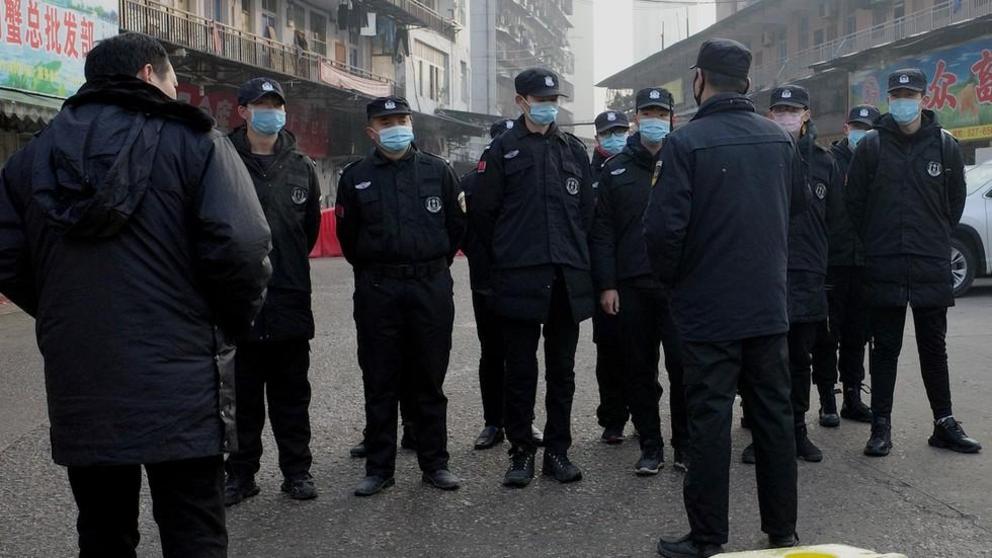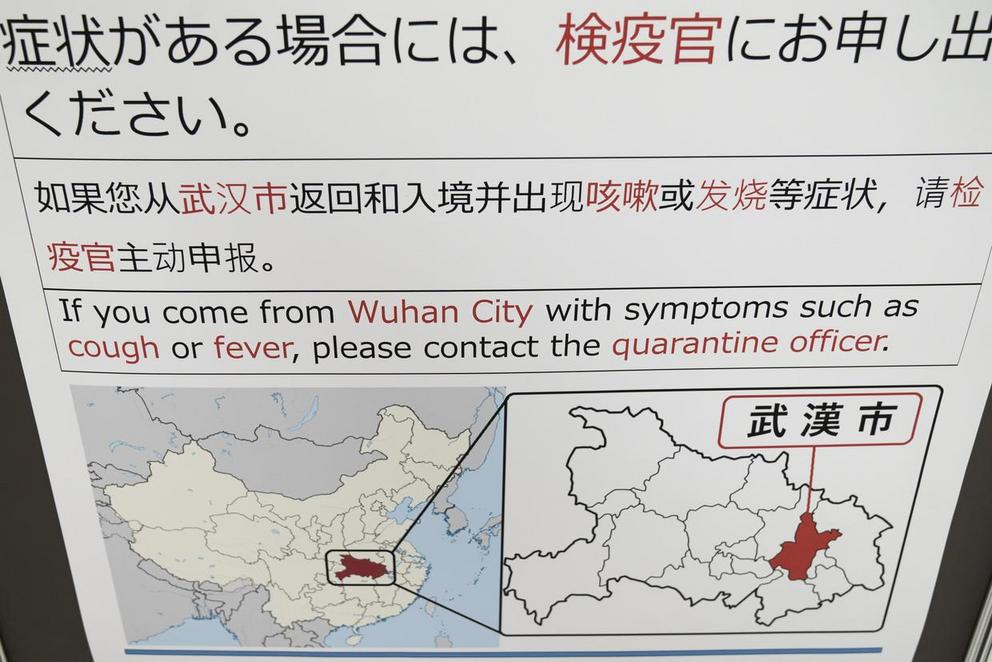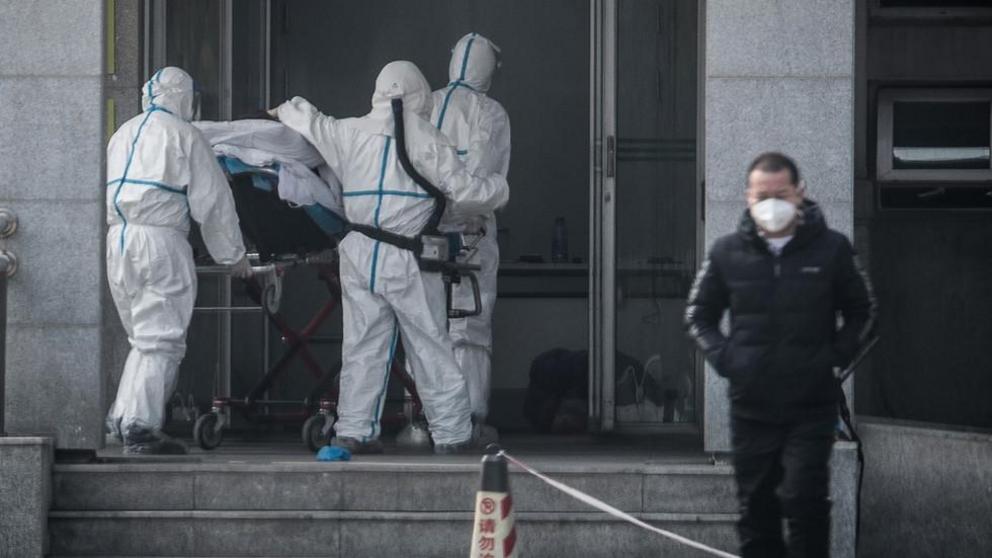China’s new killer virus is mutated SARS
... & may be one more mutation away from infecting millions. Will it make the lethal leap?
The deadly Chinese virus is turning up in more and more places, and the number of cases tripled over the weekend. But how bad could things get, and is there anything that could stop it before it’s too late?
It seems a bit like the beginning of a Hollywood thriller. An ordinary winter’s day at Wuhan’s seafood and wildlife market. Market traders, stalls packed with meat and fish, trying to flog their wares. The shoppers, handling the produce and trying to find the best deals. But Wuhan is hundreds of miles from the ocean, meaning any ‘fresh’ fish and shellfish for sale was probably anything but.

Police outside the Wuhan fish market where the SARS-like virus epidemic began to spread through Wuhan. © NOEL CELIS / AFP
We know that something at the market, perhaps a batch of dodgy crabs or some squawking chickens packed together in cages, was carrying a deadly microscopic threat. Little could punters know that hundreds, if not thousands of them, were being infected…
What is it?
The virus, 2019-nCoV, targets the respiratory system and causes coughing, fever and breathing difficulties. Fluid can be drained from the lungs, the airways cleared and expanded and oxygen delivered by mask but these are all just ways of alleviating the symptoms.
Antibiotics are useless against viruses — when you get one, the doctor tells you to get plenty of rest and gives you a lollipop. Against a virus, your body’s immune system is your only line of defense. The only real external protection against viruses are vaccines — but these can take a long time to develop, and are not always effective. Moreover, if and when the virus mutates, vaccination becomes useless — this happens almost every winter with influenza, when the doctors play a guessing game about which strains of flu will spread that year.
An old enemy comes back… different
Some have speculated that 2019-nCoV is in fact severe acute respiratory syndrome (SARS), which killed almost 800 people across Asia in 2002. DNA analysis of 2019-nCoV revealed that it is very similar to SARS — essentially a modified form. But Chinese officials are anxious to distance this new bug from SARS; perhaps they are worried that the name would panic the public. So far, their ‘Keep Calm and Carry On’ message seems to have been holding — commuters in Beijing were not overly concerned about 2019-nCoV, despite five confirmed cases there.
How far has it spread?
Wuhan, where the virus originated, is right in the center of China. By the time the first reports started coming in it had probably already spread to other Chinese cities, and now there are confirmed cases in Japan, Thailand and South Korea; all of whom are people who had traveled from Wuhan.
Thousands of people fly from Wuhan to other countries every day, and throughout the epidemic flights from Wuhan have been landing in Los Angeles, San Francisco and New York City. Passengers on those flights, as well as those to Singapore, Tokyo and Hong Kong, are now being screened for 2019-nCoV, but who’s to say how long the virus and symptoms can remain dormant before they are easily detected?

Warnings in Tokoyo's Narita airport for passengers traveling from China. © Tomohiro Ohsumi/Getty Images
It hardly matters anyway, as it is likely too late for quarantine. Experts in London believe that the Chinese officials have been playing down the extent of the epidemic, and that the true number of infected people is over ten times their figures. They estimated 1,700 last week, and it must have risen further since then. There are 11 million people in Wuhan, which makes a big target for a newly mutated virus.
How bad could things get?
Chinese scientists have been testing people close to the infected, and as it stands, they have yet to find a case of human-to-human transmission. If 2019-nCoV can only jump from its animal origin to humans then this should run its course pretty quickly—only those who contracted the disease at the market will get sick.
But if the virus is actually contagious, or it mutates to be, things could get very dire, very quickly. It would spread by the inhalation of respiratory droplets in the air, such as those sprayed around by coughs and sneezes. In developed countries, this could cause it to spread even faster than Ebola does, which can only be transmitted via bodily fluids. The recent Ebola outbreak in West Africa killed over 10,000 people, but that was with a mortality rate of 40 percent.
Since there have only been three reported deaths from 2019-nCoV so far, two of whom were elderly men, this virus is much less lethal than Ebola. But if it is even more contagious (especially as it has already reached several massive population centers) the eventual death toll could rival that of SARS, and who knows, maybe even creep into the thousands. In reality, humans are only ever one superbug away from decimation.
Happy New Year!
One small silver lining is the fact that many Chinese already wear face masks as a matter of course, to protect against air pollution. That said, this outbreak could not have come at a worse time. China will celebrate the Chinese New Year later this week, a time when everyone gets holidays from work and travels to visit faraway relatives. As a result, hundreds of millions of Chinese are on the move, on planes, trains and automobiles, in the world’s biggest annual travel rush. The dream scenario for a little virus whose only aim in life is to propagate itself by infecting as many host organisms as possible.
The World Health Organization is not currently recommending any restrictions to travel or trade—everything is under control, according to them. But in the Chinese zodiac, after January 25 we will be entering the Year of the Rat. Let’s hope that this Rat doesn’t carry a new Black Death to ravage half the world.

